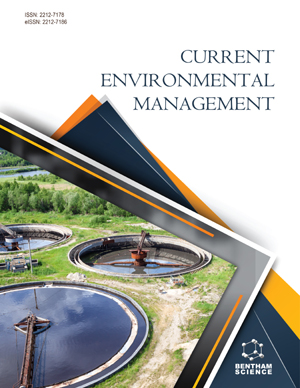Abstract
Background: Heavy metals are the most common form of environmental pollution and the evaluation of heavy metal contaminated soils is necessary for reducing the associated risks, making the land resource available for agricultural production, and enhancing food security. There are 2,000 contaminated sites in Greece, according to a previous survey report issued by the Greek Ministry of Environment, out of which 300 required immediate restoration.
Objective: This study investigated the effects of Cd, Pb, and Zn on Triticale (Triticosecale wittm.) growth in an above-referenced multi-metal contaminated site.
Methods: In order to evaluate Triticale growth in metal contaminated soil, Triticale plants were cultivated in pots filled with unpolluted and metal-polluted soils in the absence/ presence of Zeolite as an agent empowering the restoration of pollution and immobilizing heavy metals.
Results: The results showed that the Triticale plant in polluted soils with high metal concentrations, namely 4.34, 295 and 1,467 mg/kg for Cd, Pb, and Zn, respectively, can act as a “moderate” accumulator of Zn and as a “weak” accumulator of Pb and Cd; while the presence of 1% Zeolite in multi-metal-polluted soils can significantly contribute to plant growth by limiting the uptake of Cd, Pb, and Zn.
Conclusion: This study demonstrated that the addition of 1% Zeolite to multi-metal contaminated soils could minimize metal (Pb, Cd, and Zn) pollution in the environment and positively contribute to the growth of Triticale biomass for use as an animal feed within the context of sustainable development.
Keywords: Pot experiments, multi-metal-polluted soils, Triticale (Triticosecale wittm.), metal uptake, Zeolite, metal-bio-accumulator.
Graphical Abstract
[PMID: 22945569]
[http://dx.doi.org/10.1016/j.chemosphere.2013.01.075] [PMID: 23466085]
[http://dx.doi.org/10.2478/intox-2014-0009] [PMID: 26109881]
[http://dx.doi.org/10.1016/j.tibtech.2017.05.001 PMID: 28606405]
[http://dx.doi.org/10.5897/AJBX2013.13554]
[http://dx.doi.org/10.1007/s10311-018-0762-3]
[http://dx.doi.org/10.9790/3021-03510106]
[http://dx.doi.org/10.1071/CP17061]
[http://dx.doi.org/10.30638/eemj.2012.034]
[http://dx.doi.org/10.1007/s10661-013-3109-3] [PMID: 23371251]
[http://dx.doi.org/10.1016/j.chemosphere.2017.11.156] [PMID: 29220749]
[http://dx.doi.org/10.1097/00010694-193401000-00003]
[http://dx.doi.org/10.1007/s12665-010-0802-1]
[http://dx.doi.org/10.1007/s11104-005-3101-y]
[http://dx.doi.org/10.1016/j.micromeso.2011.03.024]
[http://dx.doi.org/10.1180/claymin.2015.050.1.06]
[http://dx.doi.org/10.3923/ajps.2005.533.539]
[http://dx.doi.org/10.1038/s41598-018-24715-2] [PMID: 29686313]
[http://dx.doi.org/10.1111/j.1744-7348.1991.tb04895.x]
[http://dx.doi.org/10.1051/agro:2005037]
[http://dx.doi.org/10.1016/j.jssc.2015.08.040]
[http://dx.doi.org/10.2136/sssabookser3.3ed.c15]
[http://dx.doi.org/10.2136/sssaj1978.03615995004200030009x]
[http://dx.doi.org/10.1016/j.procbio.2006.07.022]
[http://dx.doi.org/10.1016/j.biotechadv.2008.02.002] [PMID: 18353595]
[http://dx.doi.org/10.1016/S1002-0160(15)60032-7]
[http://dx.doi.org/10.1016/j.envint.2015.12.017] [PMID: 26851498]
[http://dx.doi.org/10.1088/1757-899X/200/1/012025]
[http://dx.doi.org/10.1007/s00128-009-9727-3] [PMID: 19381428]
[http://dx.doi.org/10.1023/A:1013369201003]
[http://dx.doi.org/10.1016/j.plantsci.2004.07.025]
[http://dx.doi.org/10.2134/jeq2002.1339] [PMID: 12175055]
[http://dx.doi.org/10.1002/clen.201500715]
[http://dx.doi.org/10.1016/j.jenvman.2012.02.001] [PMID: 22446136]
[http://dx.doi.org/10.1016/j.mineng.2008.09.007]
[http://dx.doi.org/10.1016/j.jhazmat.2009.04.097] [PMID: 19464110]
[http://dx.doi.org/10.1023/A:1026155423727]
[http://dx.doi.org/10.1038/sj.embor.7400445]
[http://dx.doi.org/10.1007/s10661-013-3062-1] [PMID: 23315152]
[http://dx.doi.org/10.1016/j.geoderma.2009.04.009]
[http://dx.doi.org/10.1016/j.chemosphere.2004.11.098] [PMID: 15924955]
[http://dx.doi.org/10.1080/15226514.2017.1375897] [PMID: 31274028]
 9
9 1
1


